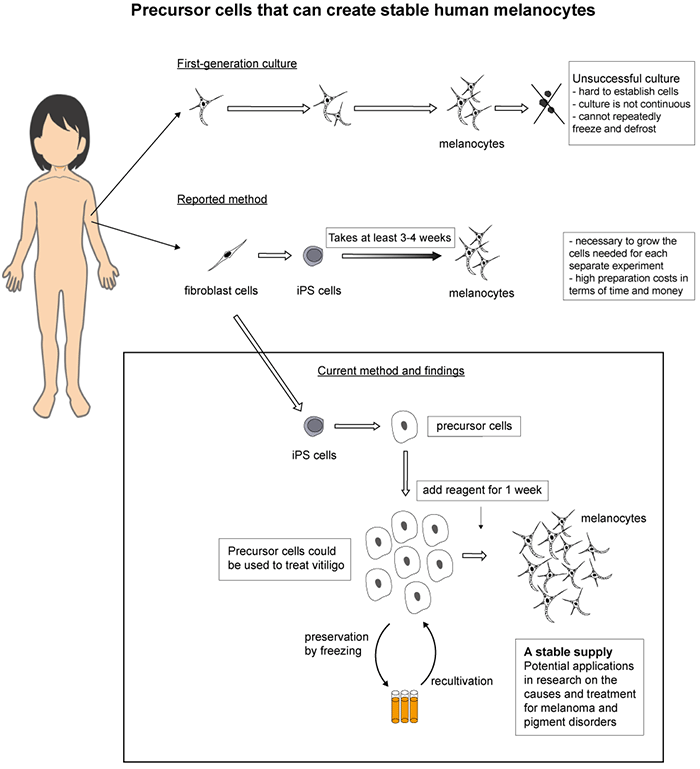Induced pluripotent stem cell (iPSC) technology offers a novel approach for conversion of human primary fibroblasts into melanocytes. During attempts to explore various protocols for differentiation of iPSCs into melanocytes, we found a distinct and self‐renewing cell lineage that could differentiate into melanocytes, named as melanocyte precursor cells (MPCs). The MPCs exhibited a morphology distinctive from that of melanocytes, in lacking either the melanosomal structure or the melanocyte‐specific marker genes MITF, TYR, and SOX10. In addition, gene expression studies in the MPCs showed high‐level expression of WNT5A, ROR2, which are non‐canonical WNT pathway markers, and its related receptor TGFβR2. In contrast, MPC differentiation into melanocytes was achieved by activating the canonical WNT pathway using the GSK3β inhibitor. Our data demonstrated the distinct characteristic of MPCs' ability to differentiate into melanocytes, and the underlying mechanism of interfacing between canonical WNT signaling pathway and non‐canonical WNT signaling pathway.

Human primary melanocytes are usually difficult to work with, especially in regard to culture maintenance, and this hinders the studies for elucidation of various functions of human melanocytes. We describe a distinctive type of cell, melanocyte precursor cells (MPCs), which are derived from induced pluripotent stem cells (iPSCs), have different characteristics of melanocytes, and, moreover, are converted to melanocytes by activating the canonical WNT pathway using the small amount of GSK3β inhibitor. It is possible that MPCs would be useful tools for studying melanocyte differentiation mechanism under WNT pathway regulation using human pigmentary disorder‐specific iPSC.
Epidermal melanocytes play an important role in photoprotection against ultraviolet radiation. Their functional defects can cause various disorders such as vitiligo, albinism, and their malignant transformation causes melanoma (Ezzedine, Eleftheriadou, Whitton, & Geel, 2015; Mort, Jackson, & Patton, 2015). While commercially available melanocytes were widely used in previous studies, most of them were melanocytes from neonatal foreskins, and we often encounter difficulties in primary culture of melanocytes from adults, especially elderly patients, and their maintenance beyond few passage numbers (Halaban, 2005). This is due to low mitotic activity in the absence of specific stimuli, such as ultraviolet radiation, phorbol‐12‐myristate‐13‐acetate (PMA), or cyclic AMP (cAMP) inducers (Eisinger & Marko, 1982; Jimbow, Roth, Fitzpatrick, & Szabo, 1975).
Induced pluripotent stem cells (iPSCs) were reported to be similar to human embryonic stem cells (ESCs) and are generated from adult human fibroblasts by the introduction of four genes, Oct3/4, Sox2, Klf4, and c‐Myc (Takahashi et al., 2007). This strong potential of iPSCs to differentiate into any type of cells facilitates the generation of iPSC‐derived melanocytes, with relative ease. Indeed, several studies using iPSC technology to convert human primary fibroblasts to melanocytes have already been reported, to explore the pathogenesis of human genetic pigmentary disorders (Mica, Lee, Chambers, Tomishima, & Studer, 2013; Nissan et al., 2011; Ohta et al., 2011) and investigate each step of melanomagenesis (Larribere & Utikal, 2014) (Larribere et al., 2015). We successfully established protocol for differentiation of iPSCs into melanocytes using feeder‐free human iPSCs, which is different from previous protocol using murine‐derived feeder cells (Nakagawa et al., 2014). Therefore, we can exclude the effects of other animal cells. In the attempt to explore several protocols for achieving differentiation of feeder‐free iPSCs into melanocytes, we found a unique and distinct cell intermediate that rapidly differentiated into authentic melanocytes in a week simply after GSK3β inhibition; it was designated as melanocyte precursor cells (MPCs). We characterized these MPCs as well as the associated factors responsible for their differentiation into melanocytes.










































